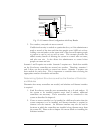
6
Preparing for the Installation
Before beginning the installation process, EverAccess recommends that the user
properly prepares by gathering certain information. Proper preparation will help
ensure a smooth installation, and will save the installer time and hassle in the
long run. The following information is essential for a professional installation:
Obtain a Floor Plan
Obtain a floor plan of the building in which the access control system is to be
installed. Obtaining a floor plan helps the installer determine what components
need to be installed, and where. It also is essential in determining the length of
cable needed to connect readers to the controller. A floor plan can be a blue
print of the building, a design, or simply a drawing of the facility. Any document
showing the footprint of the building can be used. The dimensions are
important to note, especially when determining cable lengths. A floor plan may
be obtained from your local city hall.
Determining Hardware and Location
Determining which hardware to use and where it will be installed.This is the most
crucial step in the preparation stage. First, determine how many access points, or
doors, need to be managed by the access control system. These access points will
control the security of the facility, and can limit the entry and exit to and from any
given area of the building. After deciding which doors need to be controlled, the user
must also determine the level of security needed at each door. There are many ways
to manage each door, using different resources. These resources include, but are not
limited to: prox readers, mag stripe readers, relays, and request to exits. A few
common door configurations are described below:
1. One reader, basic access control
The most basic configuration involves one card reader and an electric
strike. In this configuration, a person presents a card to the reader, and is
either granted or denied access. The electric strike unlocks if the system
grants access. Another variation of this scenario involves setting the
system up to monitor whether the door is open, which allows the system
to protect against propped open doors, or doors being held open for too
long.
2. One reader, with request to exit device
Adding a request to exit device to scenario 1 allows the system to control
when to allow people to exit through a door. Request to exit devices
include buttons that a person must press in order to exit, or a motion
detector that automatically unlocks the door when a person approaches.
These devices are always installed on the secure side of the door.


















